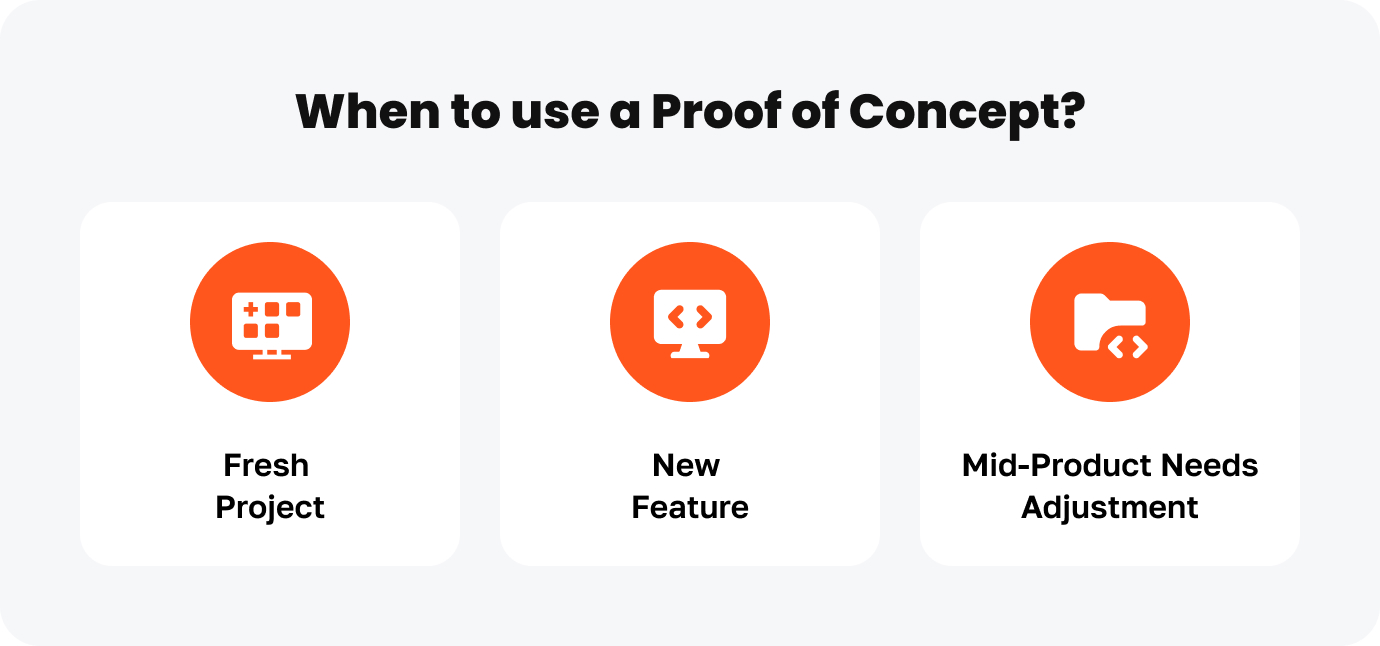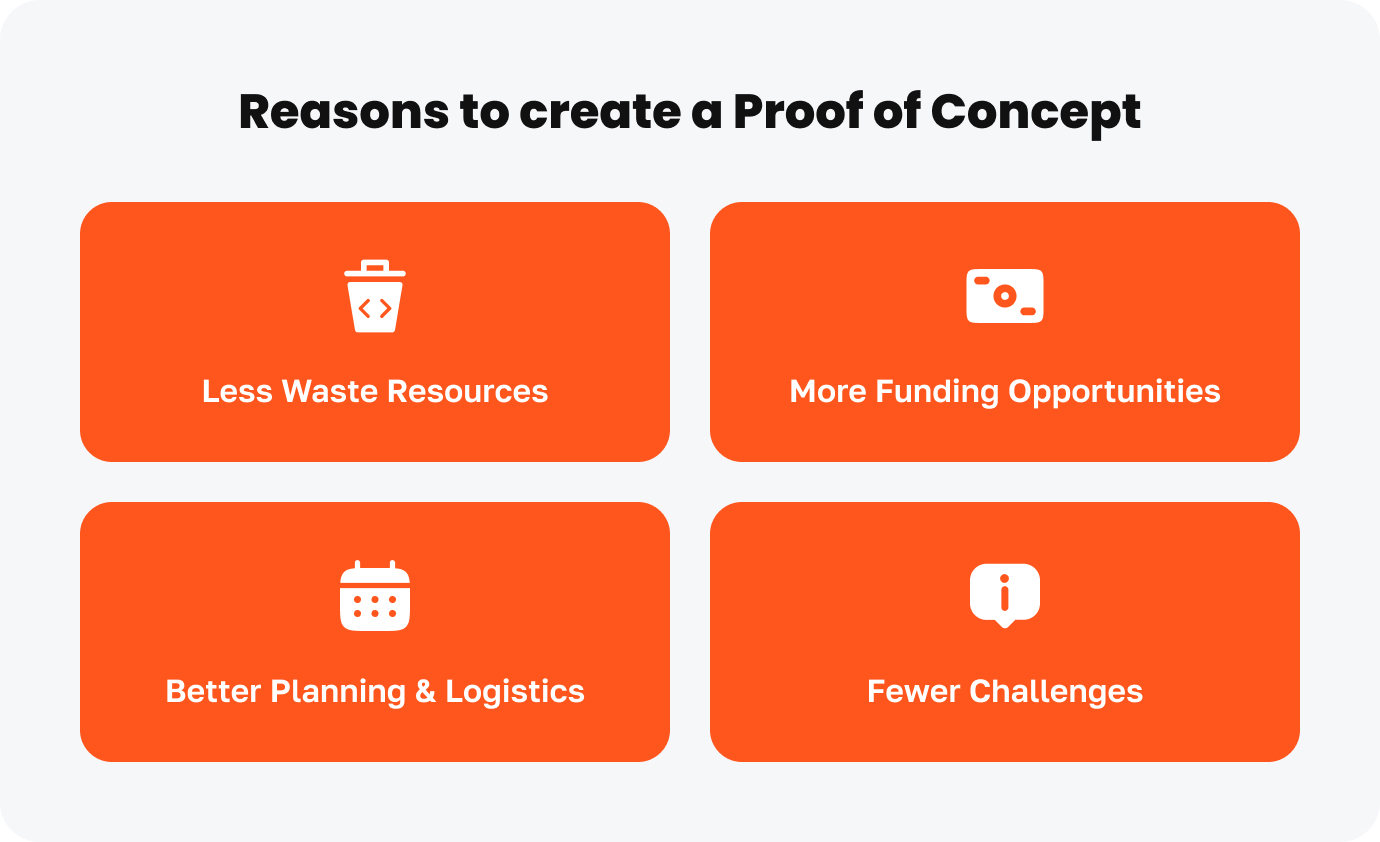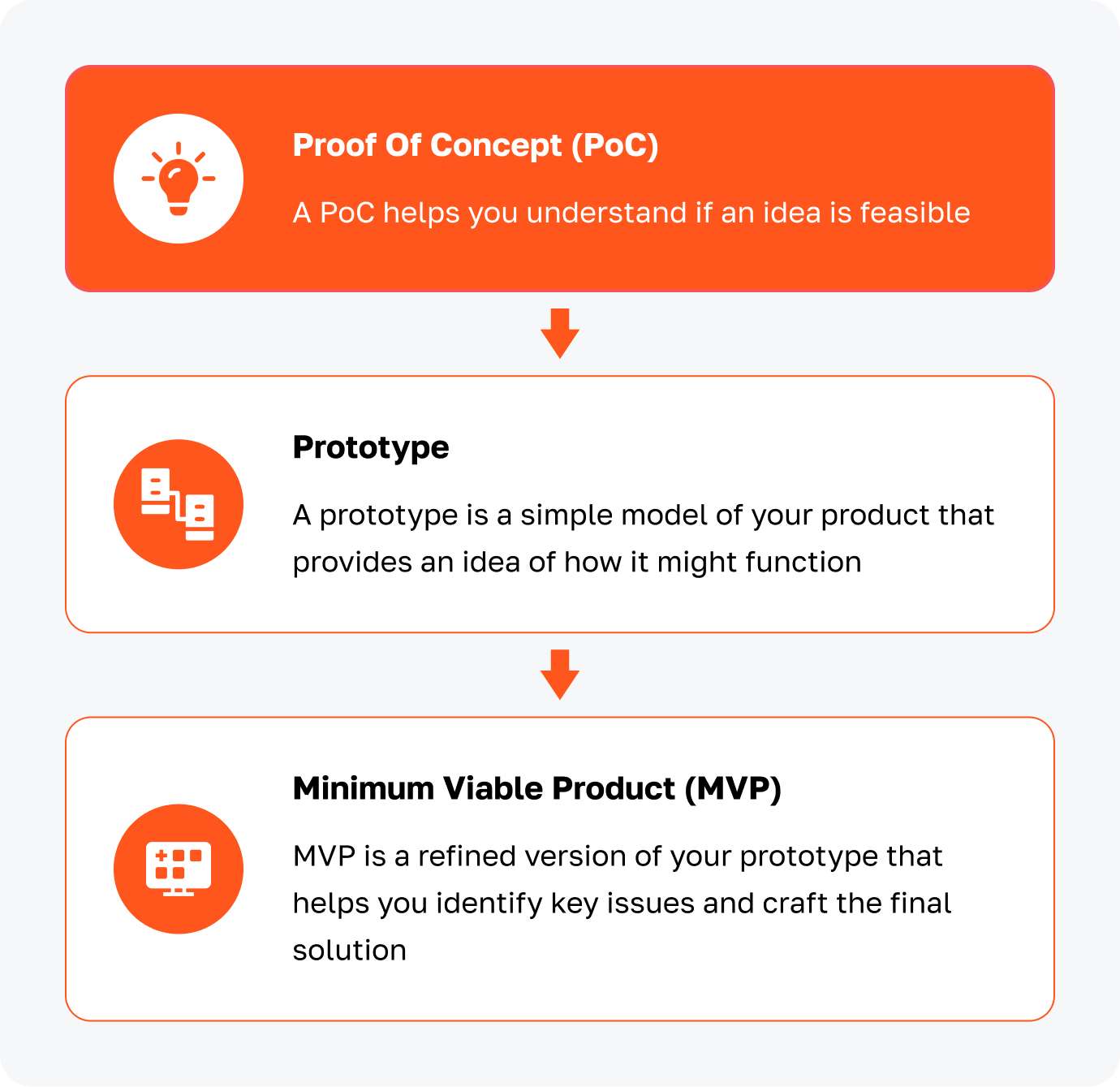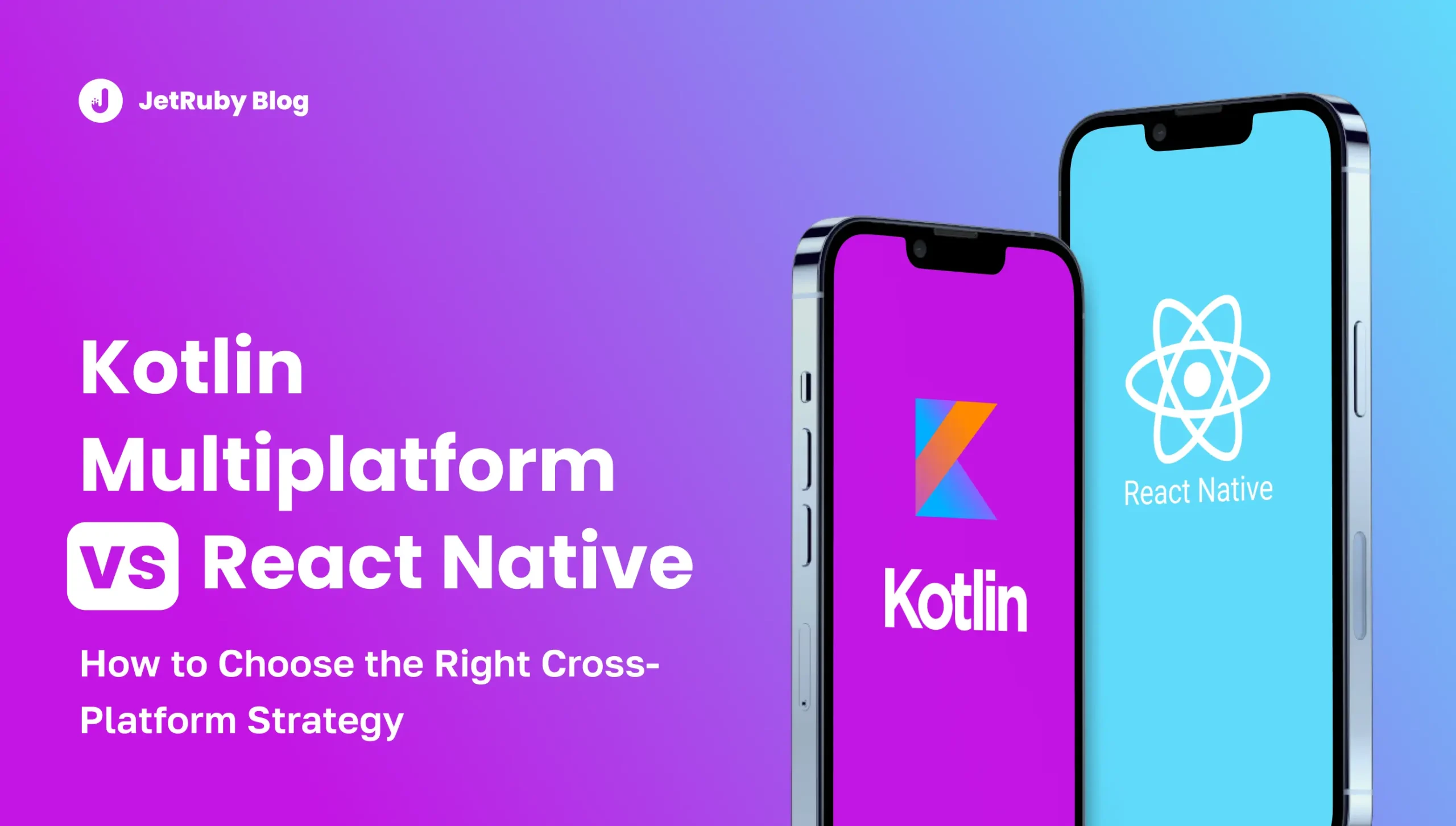Table of Contents
Many startups and companies invest time and money in ideas that never reach the market.
In fact, 90% of startups fail.
Why?
One of the reasons — they skip an important step: Proof of Concept (PoC).
A PoC in business determines if an idea is practical before full-scale development begins.
Without a PoC, companies risk building products that might fail due to technical limitations, lack of demand, poor architecture, or unforeseen challenges.
At JetRuby, PoC is an important validation process that helps us avoid costly mistakes and wasted resources.
You might ask, “What exactly do I gain from a PoC system?”
You gain confidence. Your product team learns about user demand. Investors see data. And developers confirm their approach can scale or simply work in the first place.
In this article, we’ll cover the PoC meaning, explain its importance, and share some insights on how JetRuby runs it.
Key takeaways
- Tackling too many questions at once muddles data and prolongs the process. Zeroing in on a single idea keeps the PoC fast and clear.
- A market PoC uncovers whether users want the feature you have in mind, while a technical PoC verifies if a chosen stack or library holds up under load. Both approaches share a common goal: preventing large-scale rework later.
- A small test exposes performance bottlenecks, security flaws, or lack of user engagement before you invest months of coding. This early insight is worth using since it helps avoid expenses that snowball with time.
- PoC code is often rushed, lacks security measures, and isn’t designed for long-term stability. It confirms feasibility but shouldn’t be dropped into production without a proper rebuild.
What is a Proof of Concept (PoC)?
So, what does PoC mean in business?
At JetRuby, we believe that a Proof of Concept is a small project that verifies only one assumption, one idea at a time. At least, this is how we conduct this process in our software development cycles.
It can address a question about market demand or a concern about technical limits.
Either way, the scope remains narrow.
You don’t build a finished product. Instead, you only build enough to check if the concept stands.
If it passes the test, you proceed with confidence. If it fails, you discover an early warning sign to pivot your idea before spending months of development time.
Let’s look at these two key PoC types and how they work exactly.
Market-focused PoC
A company might assume there’s a demand for a certain feature. For example, it can be a travel agency that wants to know if people love their services. Let’s say they believe users want timed quizzes at the end of each day.
They gather a test group, show them a bare-bones demo, and measure if those users engage with the quizzes two days in a row. If engagement is high, they move forward. If it’s low, they pause or adjust their concept.
- What happens in this test group?
The team invites a small slice of the user base to try the quiz feature and then gathers their reactions. They collect data about completion rates, average time spent, or user comments. - How do they gather that information?
They might use a simple interface that logs each quiz attempt. They could pair it with a quick survey. This feedback reveals if the idea has enough traction or if the audience wants something else.
Of course, they can also measure user sign-ups or app usage frequency. But they’ll require to start two more PoC processes to get accurate data for each measured aspect.
Technical-focused PoC
Developers might wonder if a certain library can handle thousands of concurrent operations. They code a minimal test that triggers many parallel requests. They monitor each response, watch for error rates, and see if memory usage spikes.
- What does that look like in practice?
The team writes a small script to stress-test the library. They run it on a staging server or local environment and then record how many requests are completed within a given timeframe. - How does that confirm feasibility?
If the library processes requests within the performance threshold without crashes, the team feels more confident adopting it for production. If it fails, they look for another library or try a different approach.
Ready to future-proof your next app with cloud application development? Learn the must-know tips for building in the cloud this year.
When do you use a Proof of Concept in software development?
Now that you know what a PoC in software development means, let’s determine when it’s used.
Most companies run a PoC during the initial project stages. They have a fresh idea and want to test it before heavy design or coding begins. This approach helps them avoid rewriting large segments of the app if something goes wrong.
For instance, a team can come up with an idea to create a marketplace for delivering fresh food within 30 minutes. A short PoC might verify if local couriers can handle that speed under certain conditions or if customers genuinely want ultra-fast deliveries.
We at JetRuby sometimes see the need for a PoC even in the middle of development.
We may realize that the current approach underperforms or that a new requirement demands an entirely different solution. Or even better — there’s a new or updated technology that we can integrate to enhance performance.
In those situations, a mid-project PoC helps us answer a single question and verify if the new direction is better.
Let’s look at typical triggers that prompt a PoC in software development.
Starting a new project
A founder or product owner may propose a brand-new concept. The team wonders if the market needs that idea. They start the Proof of Concept process to test a single assumption and measure user engagement for a core feature.
Adding a new feature to an existing product
A business might want to add a social feed or an advanced payment integration to the existing solution. The team quickly checks if the new feature meets certain performance benchmarks.
Suspecting that the current solution falls short
This can occur even during the mid-development phase.
For example, a product team might notice performance bottlenecks with the existing framework. Or developers might see that the library slows the system. Or there’s a new method to opt for.
The team finds some alternatives, but first, they need to confirm that new options can handle the load. Now it’s the right time to conduct a small PoC project to compare a few available options under test loads. This produces data about which option fits best.
Curious about the latest AI breakthroughs? Explore our top 14 AI developments shaping tomorrow’s tech.
Proof of Concept benefits
A PoC in project development delivers tangible insights without demanding a full build.
Here are 5 ways it helps teams make smarter decisions.
Confident decisions based on data
A PoC shows real metrics about performance, user feedback, or library compatibility. Instead of guessing, you see direct evidence.
How does that data assist your business?
- It convinces potential investors that you have a sound approach.
- It calms internal stakeholders who might question an unproven concept.
- It clarifies whether to invest more resources or pivot away.
Early issue identification
You set goals at the outset, like “We need a transaction speed under 25ms.” Then, you run the PoC process and compare real performance to that goal. If the PoC fails, you know about the obstacle upfront.
What qualifies as a problem in a PoC?
- Slow query times under load
- Negative user reactions to a new feature
- Inconsistent behavior when integrating with an external API
Lower costs and reduced wasted effort
You only build the minimum set of features needed to answer your question. No large-scale design or code is required.
How does this reduce wasted effort?
- You discover feasibility issues quickly.
- You avoid rewriting huge sections of code.
- You only invest heavily after you see evidence the approach works.
Stronger pitch for stakeholders
All stakeholders and investors want proof that a concept stands on real footing, not wishful thinking.
How exactly does a PoC boost your pitch?
- You show logs or performance charts.
- You share user feedback from a mini demo.
- You highlight relevant metrics instead of vague promises.
Pointing toward the next development step
A successful PoC often leads to a prototype. A failed PoC can prompt a major course correction. Instead of spending months coding the wrong solution, teams move faster toward the right fit.
Proof of Concept vs. Prototype vs. Minimum Viable Product (MVP)
Software teams often mention PoC, Prototype, and MVP in the same breath. Each represents a distinct milestone in product creation, though.
| Proof of Concept: Can this work? | Prototype: What will it look like in practice? | MVP: Which core features should be launched first? | |
|---|---|---|---|
| Core goal | Validate one assumption before investing heavily. | Demonstrate the user flow, design, and partial functionality. | Release a minimal version that actual users can adopt so you gather real-world feedback. |
| Scope | Usually no complete interface or advanced functionality. | More features than a PoC, often includes a user interface. | Contains the primary features but lacks polish or extra frills. |
| Outcome | A “yes” or “no” verdict on feasibility. | Early feedback on user experience. Stakeholders see an outline of how the product might behave in real usage. | Live data on user retention, revenue, or other success metrics in an actual market setting. |
Tired of high employee turnover? Uncover 13 actionable steps to keep your talent on board this year.
Key mistakes when conducting a Proof of Concept
A PoC in the IT industry can spare you many troubles, but it can also create confusion if done poorly.
Below are five major mistakes. Each includes an example and an explanation of how teams can sidestep that pitfall.
Mistake #1: Confusing PoC with R&D development
Example: A startup wants to build an advanced product based on computer vision. The entire R&D effort includes many tasks, like training a model, collecting image datasets, and refining detection algorithms.
On the other hand, a small PoC within that larger R&D effort can only focus on picking a library that identifies certain objects better. One library may excel at face recognition, while another focuses on squares or moving objects.
That single decision is your PoC. It addresses a narrow question: “Which library suits our primary detection need?”
Why is it a mistake?
Teams sometimes blend the entire R&D scope with what should be a much smaller PoC. This approach means no clear boundaries exist, so the project can sprawl for months without delivering a firm yes/no result.
How to avoid it
- Understand the Proof of Concept meaning and separate it from the Research and Development process.
- Outline the entire R&D plan and isolate the specific question you want the PoC to answer.
- Do not try to solve every research challenge in one short experiment.
- If the question is “Which library detects square objects faster?”, focus solely on that.
Mistake #2: Trying to test many hypotheses at once
Example: A manager says, “I want to confirm that users love our new chat feature, plus I want to pick the best cloud provider, plus I want to see if a certain database can handle 20,000 queries per second.”
They roll all of these into one PoC. The outcome might be scattered. They gather partial data, but it’s unclear which piece truly worked or failed.
Why is it a mistake?
A PoC in software development thrives on speed and clarity. Multiple unrelated hypotheses break that clarity. The results can become tangled, leading to confusion about which approach to adopt.
How to avoid it
- Separate tasks. If you must test user interest in a chat feature, do that in one PoC. If you want to compare two cloud providers, make that a different PoC.
- Keep each test short. The faster you get real data, the sooner you can adapt or proceed.
Mistake #3: Getting too deep into implementation details
Example: A founder wants to check if a new library can process user uploads in under 20ms. The team builds a gorgeous interface for file uploads, adds robust user profiles, and sets up advanced analytics.
Months pass, and the original question remains unanswered.
Why is it a mistake?
A PoC in software development aims to confirm feasibility, not deliver a polished user experience or advanced design. Adding these extra layers makes the scope balloon and jeopardizes the main goal.
How to avoid it
- Stay laser-focused on the specific question.
- Skip the user interfaces step. Use a basic form or command-line approach if necessary.
- Resist the urge to perfect the code. Speed and clarity matter more than design polish.
Mistake #4: Interpreting the results incorrectly
Example: A team tests only two solutions that appear similar.
They run a minimal load test, see that one solution “seems okay,” and ignore the possibility that a third approach they didn’t research might outperform both.
Or they gather user feedback from 20 people who work in the same department, then assume the entire market will love the idea.
Why is it a mistake?
Skewed or narrow samples can trick you into believing a concept works better than it does. You might later discover that a broader user group or an untested library yields different results.
How to avoid it
- Carefully pick your sample size or data set.
- Remain open to the idea that more than two solutions exist.
- Double-check if your test group represents real users, not just an internal team.
Mistake #5: Using PoC code directly in production
Example: A developer writes fast, rough code to check if a new integration meets the performance target.
It hits the required threshold, so management decides to copy that code into the production branch.
Later, the website or web app breaks under actual traffic or fails security tests.
Why is it a mistake?
PoC code rarely includes robust architecture, scalability, security measures, or thorough error handling. It only demonstrates that a concept is feasible in a lab environment. Rolling it out live can create hidden vulnerabilities or technical debt.
How to avoid it
- Treat the PoC code as disposable.
- Rebuild the concept once you decide to incorporate it into the final product.
- Document what worked, then re-implement those findings in a structured manner.
Boost Your Software With CTO Co-Pilot! Tackle architecture challenges and access top experts to efficiently drive your projects.
How to create a Proof of Concept
A PoC in software engineering is only as good as your planning and execution.
The steps below outline a typical roadmap.
#1. Identify the core concept
What exactly do you want to test? Do you need to know if a certain feature attracts users? Do you want to see if your architecture scales under peak loads? Can Ruby on Rails caching techniques reduce load times?
So, how exactly do you specify it?
Write a single-sentence hypothesis like: “We believe that library X can handle 5,000 data requests in 10 seconds without timeouts.”
#2. Define success metrics
Pick numbers or criteria that clarify success or failure. Transaction speed, user adoption rate, or error count are typical examples.
These metrics provide a target. For instance, “Pass if average request time is under 100ms.” If the data shows 200ms, you know it failed.
#3. Build a Minimal Test
Skip design flourishes. Focus on your single question. Write “throwaway” code that you can discard afterward.
What exactly goes into your test environment?
- A tiny app that exercises the core library
- A minimal user interface or script for data input
- A logging mechanism to track performance
#4. Collect and interpret data
Compare your actual numbers to the success metrics. If you see a match, you consider it a pass. If not, you either refine the approach or pick another tool/method/solution.
You want to monitor the following:
- Success or failure rates
- Response times
- Logs
- User feedback
- User engagement levels, if it’s a market test
#5. Share results and decide next steps
Gather key numbers, logs, or user quotes that show how the PoC performed.
Then, you can compile your outcomes in a concise format.
For instance, “We achieved a 10ms average response with a max concurrency of 30,000.” Present this to stakeholders, investors, or team members. It shows them how you tested the concept and what data you gathered.
Vue or React? See our breakdown of which framework steals the spotlight for 2025 app projects.
PoC methodology at JetRuby
Our team follows a streamlined PoC approach.
We first confirm that a concept is unknown from a technical point of view.
If there’s confusion in terms of requirements (typical non-technical business issues), those do not need a PoC. In this case, our business analysts can define and create requirements during the Design and Discovery phase.
If we see a project that comes with new technical-based integrations, unknown performance bottlenecks, or an untested feature, it’s a perfect fit to start a short PoC.
We keep the scope small, skip fancy user interfaces, and focus on the core question. That single-minded approach helps us deliver results faster. Once we collect the data, we decide if the path is valid or if we should pivot.
Moments NFC case study
A client wanted fast sub-40ms transactions through a payment gateway. Our team wasn’t 100% sure which gateway could deliver that speed.
That’s why we asked for a brief PoC to test multiple options.
We:
- Built a lightweight prototype where you scan an NFC tag with a mobile app that triggers requests through 4-5 payment gateways.
- Measured the average response time for each gateway.
- Spent around 40 hours building and testing, then compiled performance logs.
We found one gateway with an average response under 40ms.
We presented those numbers to the client, who appreciated seeing real data instead of vague assurances. This short test answered a single question and helped the client pick the gateway with confidence.
Launching a Rails app? Compare 8 Ruby on Rails hosting providers that promise peak performance and reliability.
Creating a Proof of Concept for your software product with JetRuby
SMBs often have a CTO in place but still face tricky questions about new technologies or methods.
Our CTO Co-Pilot service exists for those scenarios. We jump in as an extra layer of expertise to cover your tough architectural or performance issues.
Technical consulting
We investigate specific issues in architecture or infrastructure. We analyze the current stack, identify bottlenecks, and propose solutions based on past successes with similar platforms.
Implementation of new technologies
What exactly counts as a “new technology?”
It could be a container platform, an AI-powered solution, a shift to serverless functions, or an advanced search engine for large data sets. We write small demos, run tests to verify performance, and share best practices that minimize downtime.
Decision support for key technical questions
We examine multiple frameworks, libraries, or approaches that might solve a given need, and we rank them on cost, reliability, and performance.
We compile test data from mini-PoCs, discuss the pros and cons with the client’s CTO, and suggest a clear path forward.
Our CTO Co-Pilot is like an extension of a client’s existing team.
We offer continuous collaboration, a set schedule for tasks, and transparent updates. If a new question arises that calls for a PoC, we execute it quickly, gather results, and help the client decide on the best route.
Please contact us if you have any questions or if you need professional advice.







